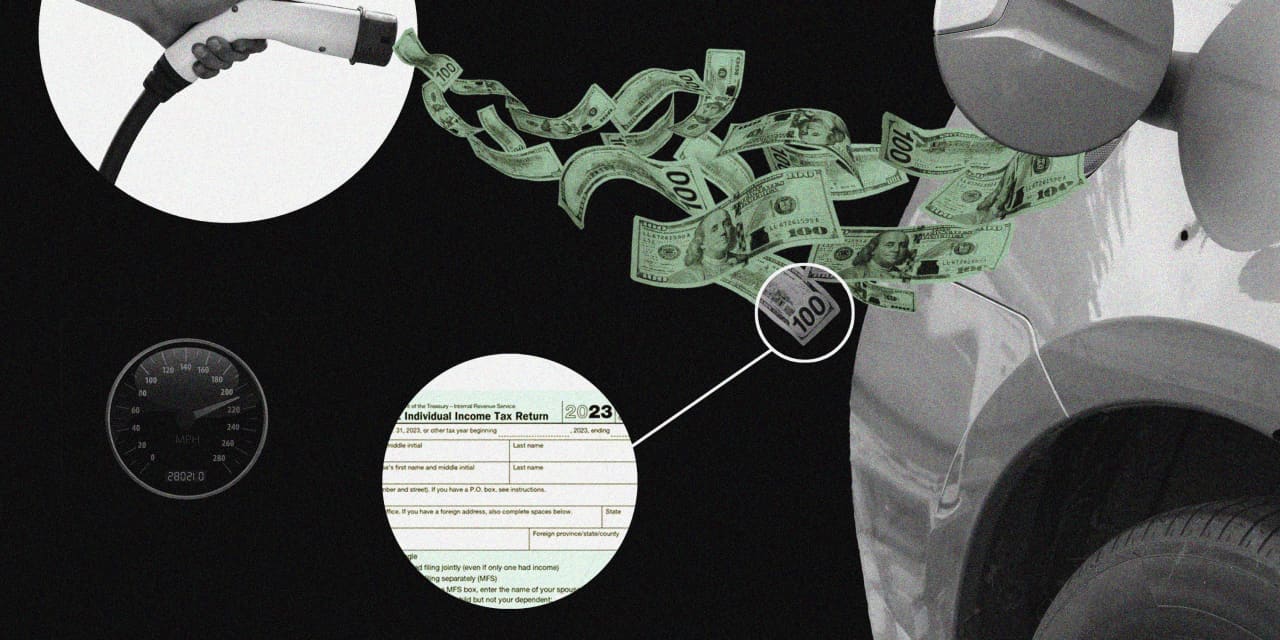Snagging federal subsidies for your EV isn’t easy.
The electric-vehicle tax credit is one of the juiciest available to taxpayers on their 2023 returns, but if you bought an EV or plug-in hybrid last year your ability to claim this benefit isn’t a slam dunk.
A web of new and often confusing eligibility requirements was passed under the Inflation Reduction Act in late 2022 and went into effect last year.
The new rules got rid of an older provision that only allowed the credit for the first 200,000 models sold of any qualifying vehicle and nixed the benefit for many buyers of popular
Tesla,
General Motors
and
Toyota
models.
Now whether you can claim some or all of the $7,500 credit will depend on your income, various vehicle and battery details, and when you took possession of your electric car, SUV or truck.
“If you’re an EV customer I can only imagine how confusing this can feel,” says Ronald Montoya, senior consumer advice editor at Edmunds.
To be eligible for the 2023 credit, you must have taken possession of the vehicle in 2023, but it isn’t enough to simply note your year of possession, Montoya says.
The size of the credit may be different depending on whether you took possession before or after April 18 of last year when new rules kicked in.
If you purchased an electric vehicle in 2023 but it wasn’t delivered until this year, you will have to wait until next year to claim the credit on your 2024 taxes.
The credit is potentially only available for buyers of new or used EVs or plug-in hybrids. If you leased a model, you can’t qualify for a tax credit—only the financing company may be eligible.
Here’s what you need to know about the 2023 credit:
Income thresholds
You may be eligible to claim a 2023 EV credit for a new car if your modified adjusted gross income doesn’t exceed $300,000 for married couples filing jointly, $225,000 for heads of households and $150,000 for single and other individual filers.
For a used car, the thresholds are halved: $150,000, $112,500 and $75,000.
You can consider either your 2023 or 2022 income for eligibility purposes. As long as your income was below your threshold in one of the two years, you can potentially claim some or all of the 2023 credit.
New vehicle requirements
The manufacturer’s suggested retail price may not exceed $80,000 for new vans, sport-utility vehicles and trucks or $55,000 for cars to be eligible for a tax credit.
A vehicle’s final assembly must be in North America, a rule that bumps Toyota and
Hyundai
models out of consideration for the credit, at least for 2023. Both manufacturers are working on opening plants in the U.S.
A vehicle’s weight must be less than 14,000 pounds, and its battery must have a capacity of at least 7 kilowatt-hours, but these thresholds aren’t prohibitive for the vast majority of clean vehicles these days, Montoya says.
The vehicle must be for your own use and not for resale, and be used primarily in the U.S.
If you gained possession of your EV or plug-in hybrid between Jan. 1 and April 17 of last year, you only need to worry about the above new vehicle requirements.
If you took delivery of your vehicle between April 18 and the end of last year, your vehicle must also meet two battery requirements: At least 50% of battery components must be manufactured or assembled in North America, and at least 40% of critical minerals must have been extracted or processed in the U.S. or one of its free trade partners, or recycled in North America.
If your vehicle only meets one battery requirement, it is eligible for half the credit, $3,750. If it meets both, it is eligible for the full credit.
As a result of the battery rules, some or all models by Audi,
BMW,
Ford,
Jeep,
Nissan
and
Rivian
that were eligible for the full credit in early 2023 became eligible for half starting on April 18.
EVs by Tesla, Chevrolet, Cadillac, Chrysler and
Volkswagen
are eligible for the full credit for all of 2023.
You can find lists of eligible vehicles during different time frames on the U.S. Department of Energy’s website.
Rules for used vehicles
For used clean vehicles, the maximum EV credit is 30% of the price with a $4,000 cap.
The EV or plug-in hybrid must be sold by a dealer for $25,000 or less.
It must also be at least two years old. If you bought a vehicle in 2023, it must have a model year of 2021 or older.
“It’s a little easier to qualify with a used vehicle because you don’t have to worry about where the vehicle is made,” Montoya says. The battery parts and minerals requirements also don’t apply.
Write to [email protected]
Read the full article here




